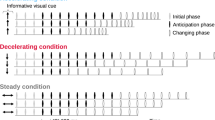Abstract
Moving to a rhythm necessitates precise timing between the movement of the chosen limb and the timing imposed by the beats. However, the temporal information specifying the moment when a beat will sound (the moment onto which one must synchronise one’s movement) is not continuously provided by the acoustic array. Because of this informational void, the actors need some form of prospective information that will allow them to act sufficiently ahead of time in order to get their hand in the right place at the right time. In this acoustic interception study, where participants were asked to move between two targets in such a way that they arrived and stopped in the target zone at the same time as a beat sounded, we tested a model derived from tau-coupling theory (Lee DN (1998) Ecol Psychol 10:221–250). This model attempts to explain the form of a potential timing guide that specifies the duration of the inter-beat intervals and also describes how this informational guide can be used in the timing and guidance of movements. The results of our first experiment show that, for inter-beat intervals of less than 3 s, a large proportion of the movement (over 70%) can be explained by the proposed model. However, a second experiment, which augments the time between beats so that it surpasses 3 s, shows a marked decline in the percentage of information/movement coupling. A close analysis of the movement kinematics indicates a lack of control and anticipation in the participants’ movements. The implications of these findings, in light of other research studies, are discussed.







Similar content being viewed by others
References
Aschersleben G, Prinz W (1995) Synchronizing actions with events: the role of sensory information. Percept Psychophys 57(3):305–317
Cariani P (1999) Closing the loop: common temporal structure in neural substrates for perception and action. Paper presented at the 9th Annual Meeting of the New England Sequencing and Timing (NEST) Workshop, Hunter Laboratory, Brown University, Rhode Island
Cooper G, Meyer LB (1960) The rhythmic structure of music. University of Chicago Press, Chicago, IL
Craig CM, Lee DN (1999) Neonatal control of nutritive sucking pressure: evidence for an intrinsic tau-guide. Exp Brain Res 124(3):371–382
Craig CM, Delay D, Grealy MA, Lee DN (2000) Guiding the swing in golf putting. Nature 405(6784):295–296
Fraisse P (1984) Perception and estimation of time. Annu Rev Psychol 35:1–36
Georgopoulos AP (2002) Cognitive motor control: spatial and temporal aspects. Curr Opin Neurobiol 12:678–683
Gibson JJ (1975) Events are perceivable but time is not. In: Fraser JT, Lawrence N (eds) The study of time, 2. Springer, Berlin Heidelberg New York
Ivry RB (1996) The representation of temporal information in perception and motor control. Curr Opin Neurobiol 6:851–857
James W (1950) The principles of psychology, vol 1. Dover Publications (original work published 1890), New York
Kolers PA, Brewster JM (1985) Rhythms and responses. J Exp Psychol Hum Percept Perform 11(2):150–167
Lee DN (1998) Guiding movement by coupling taus. Ecol Psychol 10:221–250
Lee DN, Craig CM, Grealy MA (1999) Sensory and intrinsic coordination of movement. Proc R Soc Lond B Biol Sci 266(1432):2029–2035
Lee DN, Georgopoulos AP, Clark MJO, Craig CM, Port NL (2001) Guiding contact by coupling the taus of gaps. Exp Brain Res 139(2):151–159
Mach E (1883) The science of mechanics: a critical and historical exposition of its principles. Chicago University Press, Chicago, IL
Mates J, Müller U, Radil T, Pöppel E (1994) Temporal integration in sensorimotor synchronization. J Cogn Neurosci 6:332–340
McAnally KI (2002) Timing of finger tapping to frequency modulated acoustic stimuli. Acta Psychol 109(3):331–338
McIntosh GC, Brown SH, Rice RR, Thaut MH (1997) Rhythmic auditory-motor facilitation of gait patterns in patients with Parkinson’s disease. J Neurol Neurosurg Psychiatry 62:22–26
O’Boyle DJ, Freeman JS, Cody FWJ (1996) The accuracy and precision of timing of self-paced, repetitive movements in subjects with Parkinson’s disease. Brain 119:51–70
Pastor MA, Artieda J, Jahanshahi M, Obeso JA (1992) Time estimation and reproduction is abnormal in Parkinson’s disease. Brain 115:211–225
Peters M (1989) The relationship between variability of intertap intervals and interval duration. Psychol Res 51:38–42
Rosenbaum DA, Patashnik O (1980a) A mental clock setting process revealed by reaction times. In: Stelmach GE, Requin J (eds) Tutorials in motor behavior. North-Holland, Amsterdam, pp 487–499
Rosenbaum DA, Patashnik O (1980b) Time to time in the human motor system. In: Nickerson RS (ed) Attention and performance, vol 8. Erlbaum, Hillsdale, NJ
Schubotz RI, Friederici AD, von Cramon DY (2000) Time perception and motor timing: a common cortical and subcortical basis revealed by fMRI. Neuroimage 11(1):1–12
Szelag E, Kowalska J, Rymarczyk K, Pöppel E (2002) Duration processing in children as determined by time reproduction: implications of a few seconds time window. Acta Psychol 110:1–119
Thaut MH, McIntosh GC, Rice RR (1997) Rhythmic facilitation of gait training in hemiparetic stroke rehabilitation. J Neurol Sci 151(2):207–212
Thaut MH, Kenyon GP, Schauer ML, McIntosh GC (1999) The connection between rhythmicity and brain function. IEEE Eng Med Biol 18:101–108
Treisman M, Faulkner A, Naish PLN, Brogan D (1990) The internal clock: evidence for a temporal oscillator underlying time perception with some estimates of its characteristic frequency. Perception 19:705–743
Wing AM (1980) The long and short of timing in response sequences. In: Stelmach GE, Requin J (eds) Tutorials in motor behavior. North-Holland, Amsterdam
Wing AM, Kristofferson AB (1973) Response delays and the timing of discrete motor responses. Percept Psychophys 14:5–12
Author information
Authors and Affiliations
Corresponding author
Rights and permissions
About this article
Cite this article
Craig, C., Pepping, GJ. & Grealy, M. Intercepting beats in predesignated target zones. Exp Brain Res 165, 490–504 (2005). https://doi.org/10.1007/s00221-005-2322-x
Received:
Accepted:
Published:
Issue Date:
DOI: https://doi.org/10.1007/s00221-005-2322-x




